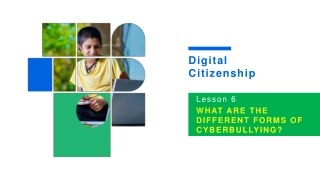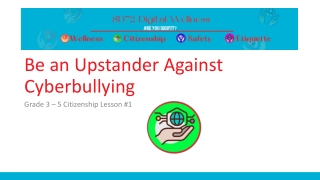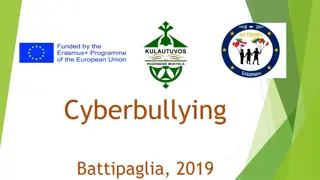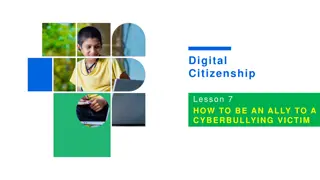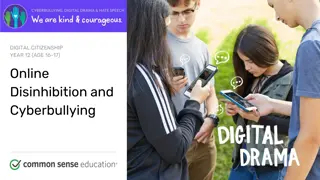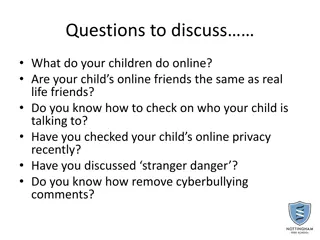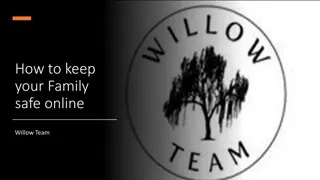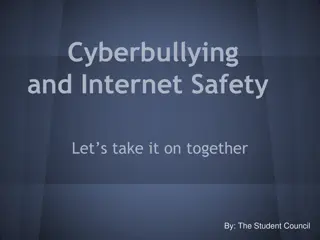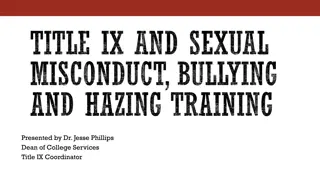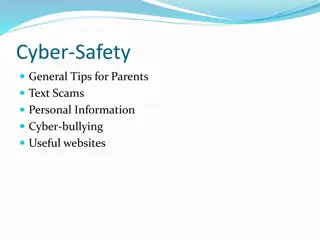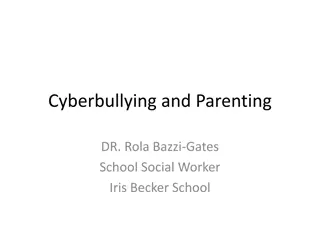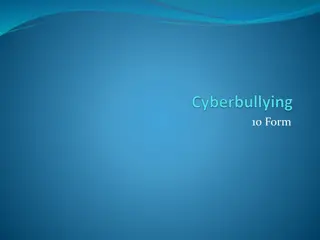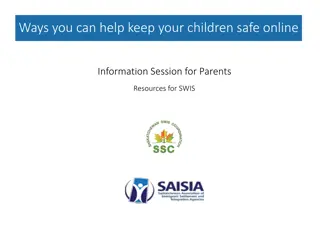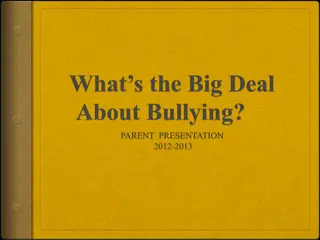Protecting Children from Cyberbullying: Awareness and Prevention
Discover the impact of cyberbullying on children through real-life stories. Learn about what cyberbullying is, its forms, and the steps to address and prevent it. Explore resources and strategies to safeguard children online.
Download Presentation

Please find below an Image/Link to download the presentation.
The content on the website is provided AS IS for your information and personal use only. It may not be sold, licensed, or shared on other websites without obtaining consent from the author. Download presentation by click this link. If you encounter any issues during the download, it is possible that the publisher has removed the file from their server.
E N D
Presentation Transcript
How to Protect Children from Cyberbullying
Rules and Expectations Place phones on silent Participate in all training activities Avoid doing tasks that are unrelated to the training Be sensitive to other participants Return from breaks on time Have fun!
Objectives Learn what cyberbullying is and how it works Discover the statistics of cyberbullying Uncover the steps for how to address cyberbullying Help protect the children in their home from cyberbullying
Video Clip https://www.youtube.com/watch?feature=player_embedded&v=_gycqAJcDFM
Amanda Todd: Timeline 2010 2011 2012 Amanda Todd was in 7th Grade when she was coerced into exposing herself on her computer s webcam by a man in his 30 s. The man, who took a screen shot of her, said he would share her photo if she did not perform more for him on her webcam. She did not and he shared her photo. Her peers began to bully her about the photo AND a failed suicide attempt involving bleach, saying she should try a different bleach and I hope she dies this time
Amanda Todd: 1996 - 2012 On September 7, 2012, Todd posted this 9- minute YouTube video entitled My Story: Struggling, bullying, suicide and self-harm. On October 10, 2012, Amanda Todd took her own life due to her experience with cyberbullying!
What is CYBERBULLYING? Cyberbullying is the use of technology to harass, hurt, embarrass, humiliate, and intimidate another person. It can be done anonymously, which makes it easy for one child to hurt another and not be held accountable or see the impact of his or her actions. Cyberbullying can take place in many ways
What is CYBERBULLYING? Three Categories of Cyberbullying: Cyberbullying Victim Cyberbully Cyberbullying Bystander
Cyberbullying Victim There are signs that a child might be a victim of cyberbullying. They may stop using the computer or cell phone Act nervous when receiving an email, Instant Message (IM) or a text. They may seem uneasy about going to school or withdraw from friends or family.
Cyberbully They may exhibit some subtle behaviors while using a computer or smartphone. They may quickly switch screens or close programs when you walk by. They often use computers at all hours of the night and day, and will usually get upset when they cannot use the computer. A cyberbully may laugh excessively while online Avoids discussions about what they are doing They use multiple online accounts. Parents can: Establish expectations for online behavior such as discussing the dangers of negative posts about others. Set consequences for cyberbullying, and model good online behavior.
Cyberbullying Bystander Many of the behaviors of the bystander are much like that of the bully. They may laugh with friends about comments written about another person. They may quickly switch screens or close programs when you walk by. They may pass information on to others about the comments made online. Parents can: Talk to your child about NOT being a bystander. Establish expectations for reporting cyberbullying when they hear about it happening. Encourage them to stand up for the victim and help them report the cyberbullying.
Cyberbullying By the Numbers NoBullying.com 2014 Statistics Over 10,000 youths were surveyed and these are the results.
Cyberbullying By the Numbers 10,000 Youth Surveyed 20% Teens That Use Cell Phones Regularly Does Not Use Cell Phone Regularly 80%
Cyberbullying By the Numbers 10,000 Youth Surveyed Report Cyberbullying 28% Had Embarassing Photo Taken Without Consent 59% Report Being REPEATEDLY Cyberbullied 13%
Cyberbullying By the Numbers 10,000 Youth Surveyed Youth Who Say They Will Never Confide In Their Parents 45% 55% Youth Who Would Confide In Their Parents
Cyberbullying By the Numbers 10,000 Youth Surveyed 5% Witnessed but Ignored Cyberbullying Witnessed and Reported Cyberbully 95%
Sexting By the Numbers Sexting Teens Approximately 39% of teens between the ages of 13-19 have sent at least one sext message 39% 48% have received one sext message 48%
Sexting By the Numbers Sexting Teens Of the teens who sext 63% said the photos were sent to a boyfriend/girlfriend 24% 29% said they sent them to somebody they were casually dating 63% 19% 19% sent these photos to someone they didn t know well and only met through a chatting app 29% 24% sent them to someone they only knew online
Legal Consequences of Teen Sexting Tennessee punishes teen sexting in part under its law against sexual exploitation of children. Under this law, it is illegal to possess images of a minor engaged in sexual activity. Originally enacted to criminalize child pornography, this law also pertains to sexual images sent via text message, and it applies to anyone--an adult or minor--who sexts with someone younger than 18. However, as described below, age is relevant for sentencing purposes. (Tn. Code Ann. 39-17-1003.) Someone who sexts with a minor may also be prosecuted for distributing or making sexual images available to a minor, or producing, exchanging, possessing, or distributing child pornography. (Tn. Code Ann. 39-17-902, -911, -1004, -1005.)
Additional Consequences Public humiliation Depression Low self-esteem Social isolation Expulsion from school Trouble getting a job in the future Difficulty getting a scholarship or accepted into college Sextortion meaning the teen could be threatened to give money, conduct sexual acts or any other act in order to keep the sext images from being distributed or shown to friends and family Could become victim of physical abuse, including sexual abuse by those he or she knows and in some cases, does not know
Tips for Talking to Kids about Sexting Ask if the teen has heard about sexting and if he or she knows anything about it Mention a story you heard on the news or in a television show and ask if he or she heard about it Ask to discuss the different things he or she shares with friends online Suggest to know what is being shared online as a means of looking out for your teen s friends Try not to lead the conversation and let the teen do the talking
How Parents Can Address Cyberbullying 1. Have the cyberbullying conversation. 2. Set cyber safety rules. 3. Know what your children are doing online.
Have the Cyberbullying Conversation: Calling All Parents https://www.youtube.com/watch?feature=player_embedded&v=1s7H7XBpZdo
Have the Cyberbullying Conversation: Initiate a conversation with your child Tell your children they do not have to accept any online activity that is meant to intimidate, threaten, tease or harm them or anyone else. Encourage your child to talk to you if anyone says or does something online that makes them feel uncomfortable.
Set Cyber Safety Rules https://www.youtube.com/watch?feature=player_embedded&v=bdQBurXQOeQ
Set Cyber Safety Rules Don t say anything online you wouldn t say to someone in person. Don t reveal anything that you wouldn t tell a stranger.
Know What Your Children are Doing Online Keep your computer in an open area of the home where you can supervise your child s online activity. Decide what websites your child can visit and which sites they will not visit. Set time limits on their computer or internet access such as not being online past 9 PM, during mealtimes, or until homework is done. Ensure that your child s settings are set to private Find out how to check your computer s history to determine where the child is visiting.
When your child is a victim of cyberbullying Do not erase or delete messages from cyberbullies. Report cyberbullying. Use software to block bullies. Reassure your child.
Poster Activity Create a poster that shows a specific technique you can use to help keep a child safe from cyberbullying.


